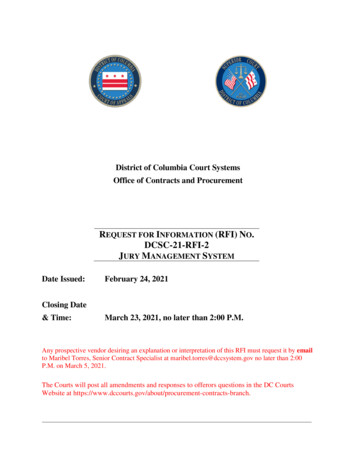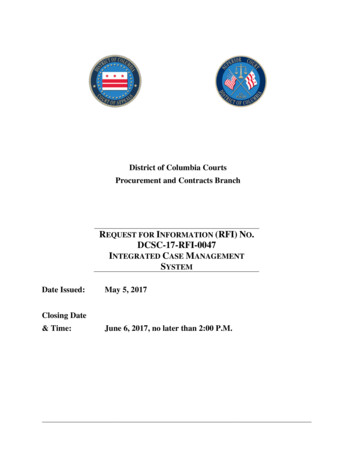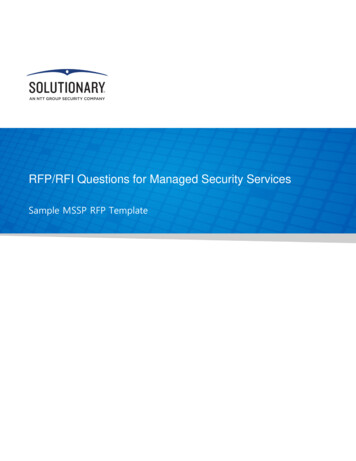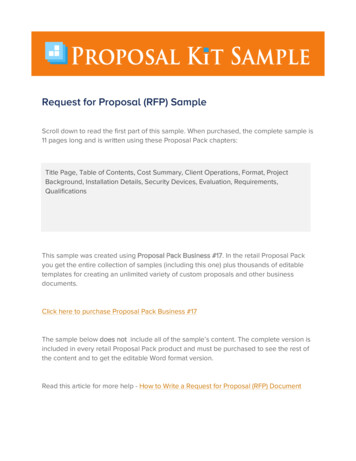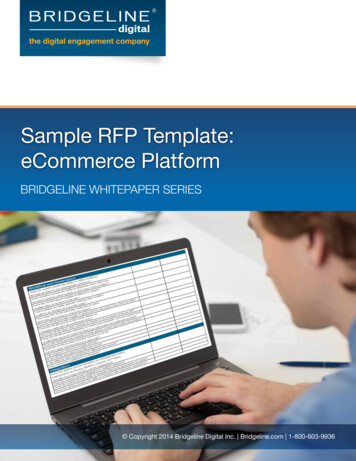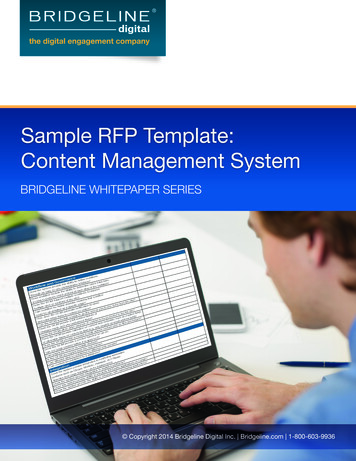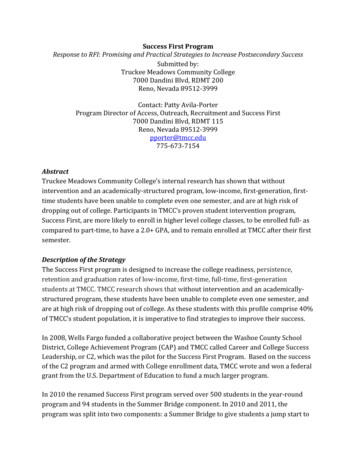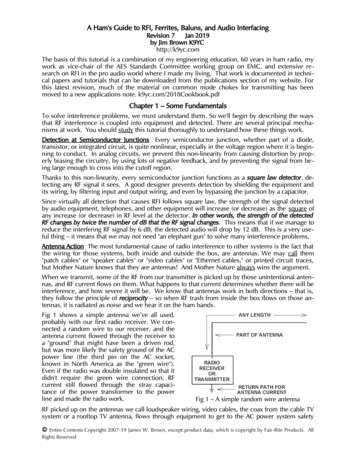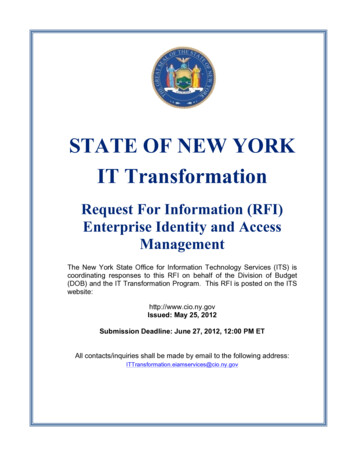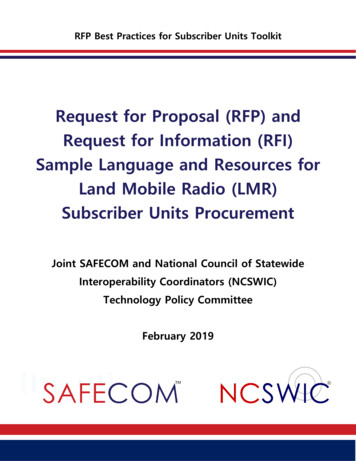
Transcription
RFP Best Practices for Subscriber Units ToolkitRequest for Proposal (RFP) andRequest for Information (RFI)Sample Language and Resources forLand Mobile Radio (LMR)Subscriber Units ProcurementJoint SAFECOM and National Council of StatewideInteroperability Coordinators (NCSWIC)Technology Policy CommitteeFebruary 2019
Sample Language and Resources OverviewIntroductionThis document provides sample text and technical resources for state, local, tribal, territorial, orregional agencies as they develop Request for Information (RFI) and Request for Proposal (RFP)documents to procure Land Mobile Radio (LMR) subscriber units. Given that agencies vary in size,scope, and resources, the sample text is not intended to introduce "one-size-fits-all" approaches toRFP, but rather to provide examples of language common to LMR subscriber units RFIs and RFPs.Agencies and entities are encouraged to use the following sample texts as a roadmap to RFPdevelopment, modified appropriately to fit the needs of the agency or entity.In addition to the sample language, this document also includes a list of general resources that maybe helpful for users when developing RFIs or RFPs. Users are encouraged to explore these resourcesto enhance their understanding of RFP development.Sample RFP and RFI LanguageFor the purposes of this document, most text reflects language from RFPs for LMR subscriber units.However, some language for the RFI is included in its own section.Most of the examples used in this document appear in publicly available RFPs and RFIs (see RFI and RFPReferences section). To remain sensitive to agency- or entity-specific information, and to make thereadability of the language uniform, all references to federal, state, local, tribal, or regional entities havebeen removed and replaced with a generic label ("AGENCY/ENTITY"). Any references to specificvendors/manufacturers or versions have also been replaced (e.g. "XYZ vendor"). Dollar and inventoryamounts are also removed ("### subscriber units," " X").Agencies and entities are encouraged to use language specific to their needs when drafting an RFP or RFI.However, the sample language below is intended to be used as a template or guide; therefore, agenciesare also encouraged to use the language as presented, should the language be appropriate for theircircumstances.RFP and RFI Sample Language and Resources for LMR Subscriber Units Procurement 1
SAFECOM-NCSWIC "RFP Toolkit"This document is included in the SAFECOM-NCSWIC Joint Technology Policy Committee’s RFP BestPractices for Land Mobile Radio Subscriber Units Toolkit, which was developed to assist users inprocuring subscriber units.RFP Best Practices for LMR Subscriber Units ToolkitRFP Best Practices for LMRDescribes subscriber units RFP best practices,Subscriber Units Procurementincluding lists of "Do's" and "Don’ts"("Do’s and Don’ts")RFP and RFI Development TimelineOutlines the timeline and significant steps infor LMR Subscriber Unitsdeveloping an RFP or RFIProcurementRFP and RFI Roles andDescribes the various roles within RFP and RFIResponsibilities for LMR Subscriberdevelopment, along with associated responsibilitiesUnits ProcurementRFP and RFI Sample Language andProvides sample content structure and language,Resources for LMR Subscriberalong with a list of general user resources, forUnits Procurementdeveloping subscriber unit RFPs and RFIsRFP and RFI Sample Language and Resources for LMR Subscriber Units Procurement 2
Table of Acronyms/AbbreviationsAcronym/Abbreviation Full Name/Title/PhraseAESAdvanced Encryption StandardANSIAmerican National Standards InstituteARPAddress Resolution ProtocolCAICommon Air InterfaceCHAPChallenge Handshake Authentication ProtocolCISACybersecurity and Infrastructure Security AgencyDESData Encryption StandardDHSDepartment of Homeland SecurityEIAElectronic Industries AllianceFDMAFrequency Division Multiple AccessFirstNetFirst Responder Network AuthorityFNEFixed Network EquipmentGAOGovernment Accountability OfficeGPSGlobal Positioning SystemIDIdentificationIPInternet ProtocolKMFKey Management FacilityLMRLand Mobile RadioLTELong Term EvolutionMHzMegahertzMNPMicrocom Networking ProtocolNCSWICNational Council of Statewide Interoperability CoordinatorsOTAROver the air rekeyingP25Project 25P25 CAPProject 25 Compliance Assessment ProgramPDAPersonal Digital AssistantPOCPoint of contactRFP and RFI Sample Language and Resources for LMR Subscriber Units Procurement 3
Acronym/Abbreviation Full Name/Title/PhrasePPPPoint-to-Point ProtocolPTIGProject 25 Interest GroupPTTPush to talkRCPRadio Control ProtocolRFCRadio Frequency ComponentsRFIRequest for InformationRFPRequest for ProposalRFQRequest for QuotationsRFSSRadio Frequency SubsystemRSIRadio Set IdentificationSLIPSerial Line IPSNDCPSub Network Dependent Convergence ProtocolSNMPSimple Network Management ProtocolSORStatement of RequirementsSOWStatement of WorkSUSubscriber unit(s)TCPTransmission Control ProtocolTIATelecommunications Industry AssociationUDPUser Datagram ProtocolUSBUniversal Serial Busv (e.g., v4)Version (version and version number)WACNWide Area Communications NetworkRFP and RFI Sample Language and Resources for LMR Subscriber Units Procurement 4
Sample LanguageRFI vs. RFPThough comparable, the RFI and RFP documents have significant differences in language, content, andterminology. Major differences between the RFI and the RFP are included below.Key Terminology - RFI vs. RFP (* Note: Emphasis added below)Request for InformationRequest for ProposalsAgency/EntityAgency or entity: Preferred name orAgency or entity: Preferred name orand Vendor(s)acronym of procuring agency or entityacronym of procuring agency or entitytitles(state, county, city, district, tribe, territory,(state, county, city, district, tribe, territory,or federal agency or other entity)or federal agency or other entity)Vendor: Respondee, Offeror, Vendor,Vendor: Proposer, Offeror, Vendor, Bidder,Industry, Responding Party/EntityProspective Vendor, RespondingInterested PartyParty/Entity, Interested Party(Note: RFI respondees are not consideredProposers)RFI or RFPTHIS IS A REQUEST FOR INFORMATIONThe AGENCY/ENTITY is releasing thisintroduction(RFI) ONLY. This RFI is issued solely forRequest for Proposal (RFP) to procureinformation and planning purposes – itLand Mobile Radio (LMR) subscriber unitsdoes not constitute a Request forequipment and associated servicesProposal (RFP) or a promise to issue anaccording to a Project (P25) Public SafetyRFP in the future. This request forRadio System and in accordance with theinformation does not commit therequirements of this Proposal invitationAGENCY/ENTITY to contract for anyand any resulting contract.supply or service whatsoever. Further, theAGENCY/ENTITY is not at this timeseeking proposals and will not acceptunsolicited proposals. Respondees areadvised that the AGENCY/ENTITY will notRFP and RFI Sample Language and Resources for LMR Subscriber Units Procurement 5
Key Terminology - RFI vs. RFP (* Note: Emphasis added below)Request for InformationRequest for Proposalspay for any information or administrativecosts incurred in response to this RFI; allcosts associated with responding to thisRFI will be solely at the interested party’sexpense. Not responding to this RFI doesnot preclude participation in any futureRFP, if any is issued. It is theresponsibility of the potential offerors tomonitor AGENCY/ENTITY sources foradditional information.PurposeThe objectives of the RFI are to get aThis Request for Proposal (RFP) is beingstatementbroad overview of what is available inoffered for the procurement of variousthe marketplace and to create a short listtypes of Subscriber Radios for publicof units to be considered for a largesafety and emergency services.quantity purchase. Therefore theIn this procurement, AGENCY/ENTITY istechnical specifications are merely ansoliciting competitive bids for productsexpression of the intent, not a restrictiveand/or services, which may be purchasedlist of must-meet requirements.by the AGENCY/ENTITY during thecontract term.ProjectRequirements - stated in the form of anRequirements - stated in the form of arequirementsinquiry, for example:requisite, for example:"AGENCY/ENTITY is aware of the"All radio subscriber internal softwaretechnology that allows for cellularshall be downloadable from aphones and other LTE capable devices toprogramming device (e.g., laptop, PDA)pass voice traffic over P25 systems usingwithout the need to replace internalencryption. AGENCY/ENTITY would likecomponents for new software versions.information on these types of productsProposers shall provide radio subscribersand how the system can be integratedequipped for over-the-air reprogrammingwith broadband technology in theof both system configuration parametersfuture."*and internal operating software."*RFP and RFI Sample Language and Resources for LMR Subscriber Units Procurement 6
Cover/Title PageRFP Sample Cover / Title PageAGENCY/ENTITYREQUEST FOR PROPOSAL(RFP #0000)P25 LAND MOBILE RADIO SUBSCRIBER UNITSREPLACEMENTIssued: Month Day, YearProposal Due: Month Day, YearSubmissions Mailing Address:AGENCY/ENTITY Name or Point of Contact Full NameAddress Line 1City, State Postal CodeAnticipated Award: Month Day, YearContact Information:Point of Contact Full NameAddress Line 1City, State Postal CodeAgency ProfileAll RFPs and RFIs should include basic information about the agency or entity releasing the request. Theprofile is typically included as part of the "long title" of the RFI or RFP (outlined on the first page of theRFI/RFP). The agency or entity information may include the following elements:RFP and RFI Sample Language and Resources for LMR Subscriber Units Procurement 7
Agency/entity name Contact information/point of contact Submission information, including mailing address RFP/RFI number (as applicable) Issue dateBackground and TimelineIssuing agencies should include a timeline (due date) so that the proposers have an expectation as towhen to submit proposals. Additionally, the purpose and scope of the agency or entity's procurementinquiry and any relevant background information is useful for proposers.Sample Language - Background and TimelineSectionSample LanguageBackgroundThe existing AGENCY/ENTITY systems includes ### LMR subscriber units,including ### mobile and ### portable radio units. The AGENCY/ENTITYsystem utilizes a conventional/Phase I trunked/Phase II trunked XYZ systemwith ### repeated tower sites throughout the AGENCY/ENTITY geographicalarea. XYZ Vendor accounts for ### of Model No. subscriber units.PurposeThe primary objective of the AGENCY/ENTITY is to acquire LMR subscriberunits to meet operability, interoperability, equipment, equipment support,and training needs.ScopeAGENCY/ENTITY requires professional grade portable/mobile radios that areANSI/TIA/EIA-102 compliant commonly referred to as Project 25 (P25) thatmeet the minimum specifications (see attached P25 specifications). Theradios must also be capable of operating on the AGENCY/ENTITY’s existingXYZ Vendor X-- MHz (megahertz), analog, trunked radio system as well as P25 X--/Y-- MHz trunking and conventional protocols.AGENCY/ENTITY anticipates that a quantity up to X radios may be purchasedfrom this master contract, over the term of the contract, but makes nocommitment to procure any specific minimum quantity.RFP and RFI Sample Language and Resources for LMR Subscriber Units Procurement 8
TimelineThe timeline provided includes current dates and deadlines as a generalguideline and is subject to change at the AGENCY/ENTITY's sole discretion.Unless stated otherwise, consider the dates below to be the projecteddeadlines for each stage of the RFP. The following events represent eventsthat may require dates or timeframes in the RFP process: Issue date Mandatory pre-proposal conference (optional) Site location survey visits (optional) Written questions deadline Bid opening date Proposal due date (final deadline) Scripted demonstrations Anticipated award Contract negotiations(Note: Not inclusive to all events issuing agencies or entities may include aspart of the proposal submission and selection process)Formatting and Content RequirementsMany RFPs include formatting or content requirements to ensure uniformity among proposals received.This is helpful for ease of access, data comparison, and general organization.The following elements of a proposal submission are common formatting and content features: Sections of the proposal (e.g., technical requirements, pricing) Attachments or number of attachments Cover letter, executive summary, and/or table of contents References Timeline projections for implementation Pricing spreadsheet or equivalent Key personnel or points of contact Description of proposed capabilities or equipment Letter of Transmittal, Statement of Work (SOW), or other useful attachmentsRFP and RFI Sample Language and Resources for LMR Subscriber Units Procurement 9
Submission GuidelinesIn addition to the RFP deadline and formatting requirement, submission guidelines ensure that proposersare aware of agencies' expectations during the submission process. For example, some agencies mayprefer to receive a physical copy of the proposal in the mail, while other agencies may prefer digital only.The submission guidelines will also alert the proposers of any attachments required as part of theproposal submission. The following list includes several other examples of guidelines: Authorized signature Changes to proposals Time of receipt and acceptance of proposals Financial statements License requirements or authorization to transact business Physical, digital, oral, or facsimile submission requirements (e.g., submission must be printed andsubmitted in three-ring binders; no submission will be accepted over the phone) Specified number of copies to be submittedTechnical Requirements for Subscriber UnitsConsidering the wide variance in subscriber unit needs, not all RFPs and RFIs will include the sameformatting or level of technical detail.If P25 is the desired choice for subscriber units, the agency may want to require compliance with the TIA102 suite of Standards and consult resources such as the CAP P25 Approved Equipment List and RFPsfrom jurisdictions with similar needs (see Technical Resources section).Below are two tables: the first table (page 11) includes a list from a user's sample RFP. The second table(page 12) includes capabilities enabled by the TIA-102 Standards for P25-compliant subscriber units (thesecapabilities reflect standards for FDMA voice services for P25 Trunking Phase I). Note that the featureslisted in either table do not represent a comprehensive list of all available subscriber units features.RFP and RFI Sample Language and Resources for LMR Subscriber Units Procurement 10
Technical Requirements - Subscriber Unit Features from Sample RFPEmergency CallbackActivation/Reception Battery Life Indication Dynamic Regrouping Charging Mode Indication Individual Call Transmit and Receive Indicate Telephone Interconnect Call Programming Mode Activation Selective Alert Software Upgrade Mode Console Alert Tone(s) Subscriber-Generated Feature AcknowledgmentEvacuation Tone Channel BeaconMode Announcement (voice Voice Communications Modedirectory for programmable Data Communications Moderadio modes) Priority ScanningFailure Modes (e.g., loss of Home Mode Activationtrunking control, loss of wide Talkaround/Direct Modearea communications) Ready-to-Talk Trunks Busy Vehicular Repeater Mode.Mobile Radio Unit Power supply External data portfeatures Equipment housing Microphone/microphone cord Radio unit display features Speakers/remote speakers Enable/disable scanning Keypad lock/unlockPortable Radio Unit Power supply External data portsfeatures Batteries/adapter/charger Belt clip/radio unit holster Equipment housing Volume control Radio unit display features Microphone Channel selection Headset/earpiece/BluetoothAudible and visual signaling Activationaccessoriesswitch/button/knob Emergency status Keypad lock/unlockswitch/button/knob Date/time displayRFP and RFI Sample Language and Resources for LMR Subscriber Units Procurement 11
Technical Requirements - Capabilities Enabled by TIA-102 Standards for Subscriber UnitsVoice Service - Common Air Interface (CAI)The below list includes the P25 Frequency Division Multiple Access (FDMA) voice services - or Common AirInterface (CAI) services - for P25 Trunking Phase I defined in published TIA-102 Standard documents.Voice callsConventional or Group Voice CallTrunked Emergency Group Voice CallConventional Unaddressed (Analog) Voice Callsubscribers only Individual Voice CallTrunked Broadcast Call Message Trunkingsubscribers only Announcement Group Call Transmission Trunking System Call Conventional Fallback Individual Call with Individual Voice Call withoutsubscribersAvailability CheckAvailability Check Call Alert Radio Unit MonitoringTrunked Discreet Listening Short Messagesubscribers Emergency Alarm Status Query Radio Check Status Update Radio Unit Inhibit/Uninhibit Transport of Talking PartySupplementary Conventional orservicesIdentificationConventional Busy Channel Lockout Monitor Squelchsubscribers only Normal Squelch Selective SquelchTrunked Emergency Alarm Cancellationsubscribers only Group Emergency Cancellation Priority Call Pre-emptive Priority Call Call Interrupt (Wireline Console Outbound Audio Takeover) Radio DetachMobility andTrunked Unit Registration; Home SUsregistrationsubscribers only Unit Registration; Inter System SUs Unit Registration; Inter WACN SUsservicesRFP and RFI Sample Language and Resources for LMR Subscriber Units Procurement 12
Secure Unit Registration; (Radio Authentication); Home SUs Secure Unit Registration; (Radio Authentication); Inter System SUs Secure Unit Registration; (Radio Authentication); Inter WACN SUs Location Registration Unit Deregistration Affiliation; Home Talkgroups Affiliation; Inter System Talkgroups Affiliation; Inter WACN Talkgroups Call Restriction (Authorization) RFSS Polling Request (without Capabilities) RFSS Polling Request (with Capabilities) RFSS Polling Response (without Capabilities) RFSS Polling Response (with Capabilities) RFSS Polling; RFSS Functional Capability RFSS Polling; RFSS Adjacent Site Status RFSS Polling; RFSS Unit/Group Roaming Capability RFSS Polling; Known Status RFSS Polling; RFSS Vocoder Mode ConveyanceTelephoneConventional or Landline to Group CallinterconnectTrunked Landline to Unit Callsubscribers Unit to Landline Call Dialing Side Tone 34-digit Dialed Number Generate Hook Flash Conventional Disconnect Code Overdial Trunked Interconnect Availability CheckTrunkedsubscribers onlyVoiceConventional or AES EncryptionencryptionTrunked DES EncryptionsubscribersRFP and RFI Sample Language and Resources for LMR Subscriber Units Procurement 13
Data Bearer ServicesThe below list includes the P25 FDMA non-voice services related to Data Bearer Services defined inpublished TIA-102 Standard documents.BlockConventional or AES EncryptionEncryptionTrunked DES al Static Registrationmanagementsubscribers only Dynamic Registration Mobility Tracking Data ScanservicesCAI dataConventional Confirmed Data Packet Deliverybearer servicesubscribers only Unconfirmed Data Packet DeliveryIP data bearerConventional or Context ManagementserviceTrunked Confirmed IPv4 Datagram Conveyancesubscribers Unconfirmed IPv4 Datagram Conveyance RFC-1144 TCP/IP Compression RFC-2507 UDP/IP Compression Challenge Handshake Authentication Protocol (CHAP) Fixed Network Equipment (FNE) Controlled SU ControlledConventional Static IP Address Bindingsubscribers Dynamic IP Address Binding via ARP SNDCP data Channel AllocationonlyTrunkedsubscribers onlyCAI Data Bearer Service ApplicationsThe below list includes the P25 FDMA non-voice services related to CAI Data Bearer Services Applicationsdefin
Request for Information (RFI) Sample Language and Resources for Land Mobile Radio (LMR) . the sample language below is intended to be used as a template or guide; therefore, agencies . "All radio subscriber internal software shall be downl
